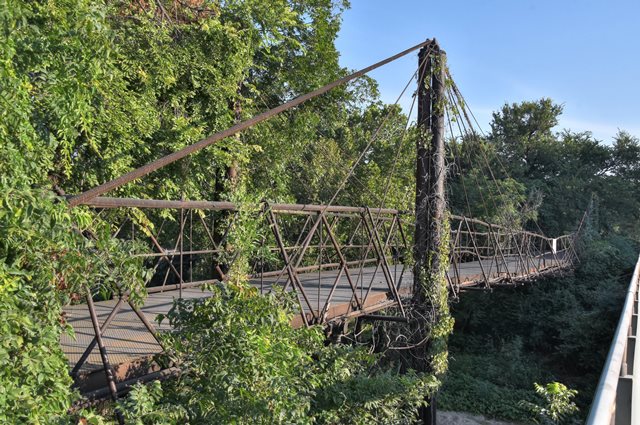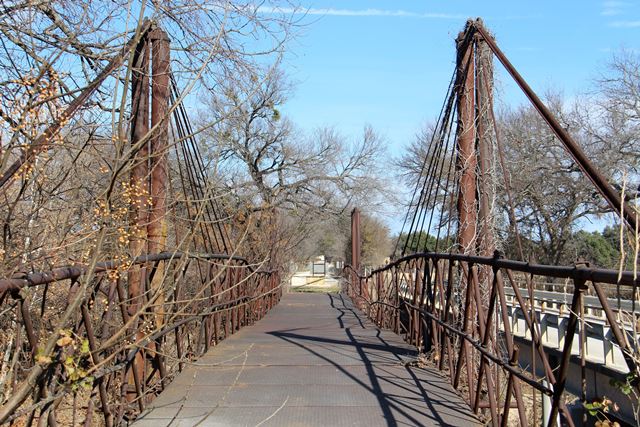We Recommend:
Bach Steel - Experts at historic truss bridge restoration.
BridgeHunter.com Phase 1 is released to the public! - Visit Now
Bluff Dale Bridge
Bluff Dale Suspension Bridge

Primary Photographer(s): Nathan Holth
Bridge Documented: August 2, 2019 and July 7, 2022
Near Bluff Dale: Erath County, Texas: United States
1890 By Builder/Contractor: Runyon Bridge Company of Weatherford, Texas and Engineer/Design: Edwin Elijah Runyon
1934
140.0 Feet (42.7 Meters)
519.3 Feet (158.3 Meters)
10.5 Feet (3.2 Meters)
3 Main Span(s)
Not Applicable

View Information About HSR Ratings
Bridge Documentation
This bridge's future is at risk!
Bridge Status: This bridge is abandoned and as of 2020 is at extreme risk for collapse by neglect, with demolition plans in place!This nationally significant historic bridge is now on the verge of collapse, a condition that has developed this year as the result of recent floods. Scour has undercut a concrete foundation on which the tower rests, and one of the towers has dropped enough that the deck now has a significant sag to one side. One of the supporting bents under the towers has also snapped. The county is now pursuing DEMOLITION of this NATIONALLY SIGNIFICANT historic bridge on the claim that when it collapses it will destroy the modern bridge next to it. The county further claims it does not have the needed money to non-destructively dismantle the bridge and place it into storage. So, in short, unless a source of funding can be found to dismantle and put the bridge in storage or perhaps repair it in place, this bridge is otherwise in imminent doom, whether by collapse of demolition.
View Historic American Engineering Record (HAER) Documentation For This Bridge
HAER Drawings, PDF - HAER Data Pages, PDF - Texas Suspension Bridges HAER Data Pages, PDF - Texas Cable Bridges Structural Study HAER Data Pages, PDF - Flinn Model and Plaque, Austin, TX, HAER Photos, PDF
View National Register of Historic Places Nomination Form For This Bridge
View All Runyon Bridge Patents
This bridge is shown in many documents as the "Bluff Dale Suspension Bridge" however HistoricBridges.org finds this name misleading and confusing because while a cable-stayed bridge can be thought of as a form of suspension bridge, in nearly every case a "cable-stayed" bridge is recognized to mean something different than a "suspension bridge." This is a cable-stayed bridge, and one of the oldest... if not the oldest... true cable-stayed bridge in the country. It is known to be the oldest in Texas.
The Bluff Dale Suspension Bridge is located in Erath County, Texas. Although abandoned, it is one of the most significant historic bridges in Texas as the oldest known cable-stayed bridge in Texas, and perhaps the country. The bridge was built in 1890 by the Runyon Bridge Company, Weatherford, Texas, and is a wire cable-stayed bridge with a stiffening truss composed of tubes and cast iron connecting pieces. It was repaired by the Flinn-Moyer Bridge Company of, Weatherford, Texas, in 1899. Company owner William Flinn had previously worked with Edwin Elijah Runyon at the Runyon Bridge Company. It is assumed that the Howe stiffening truss of tubes and castings were added at this time, since other Runyon bridges did not have this stiffening truss, while other William Flinn bridges did. In 1934 the bridge was replaced and moved from its original location on the Stephenville-Granbury Road upstream a short distance to what is today CR-149. It remained open to traffic in this location until the early 1990s when a new bridge was built. Today the bridge is abandoned and at high risk of eventual collapse due to neglect.
The basic thinking of cable-stayed and suspension bridges goes back to as early 282 B.C. In more recent history, the United Kingdom and the United States engaged in some experimentation with cable-stayed designs such as the 1873 Albert Bridge in London and the 1866 Roebling Bridge in Cincinnati, Ohio. Many of these early bridges were a combination of suspension and cable-stayed designs. However, Runyon designed the Bluff Dale Bridge as a true cable-stayed bridge with no parabolic suspension cable. As such, it stands out as an unusual bridge. His design did not catch on at the time, nor does it appear to have received much attention from the engineering community of the period. This is ironic since the design is essentially a prototypical example of a bridge type that reemerged after World War II to become a very popular bridge type. In fact, the cable-stayed bridge is today one of the most common long-span bridge types to be built in new bridge construction.
While it is admirable that this bridge was not demolished when a new bridge was built next to it, it is also unfathomable that this bridge has been abandoned and allowed to deteriorate to the point that it is closed to all traffic including pedestrian traffic. This 19th century bridge is a prototype of one of the most important bridge types of the 21st Century. It is a unique and highly significant bridge and its preservation and restoration should be given the absolute highest priority.
Above: Runyon patent for a cable-stayed bridge.

Above: Drone view of bridge in 2022. Photo Credit: Jesse Berube
Text From Bridge Interpretive PlaqueFor at least 20 years vehicles had to ford the Paluxy River to reach Bluff Dale and points west. Wagon traffic increased after the Fort Worth & Rio Grande Railroad line reached the town in 1889. This iron bridge began to serve the public by spanning the Paluxy about 1891, on the main access road that became State Highway 10 and later U.S. 377. By 1933 arterial highway travel demanded a wider bridge. In 1934 authorities moved the "swinging" bridge 1.5 miles upstream where it serves local traffic. (1978) |
This bridge is tagged with the following special condition(s): Unorganized Photos
![]()
Photo Galleries and Videos: Bluff Dale Bridge
2019 Bridge Photo-Documentation
Original / Full Size PhotosA collection of overview and detail photos. This gallery offers photos in the highest available resolution and file size in a touch-friendly popup viewer.
Alternatively, Browse Without Using Viewer
![]()
2019 Bridge Photo-Documentation
Mobile Optimized PhotosA collection of overview and detail photos. This gallery features data-friendly, fast-loading photos in a touch-friendly popup viewer.
Alternatively, Browse Without Using Viewer
![]()
2022 Additional Unorganized Photos
Original / Full Size PhotosA supplemental collection of photos from Jesse Berube including drone photos that are from additional visit(s) to the bridge and have not been organized or captioned. This gallery offers photos in the highest available resolution and file size in a touch-friendly popup viewer.
Alternatively, Browse Without Using Viewer
![]()
2022 Additional Unorganized Photos
Mobile Optimized PhotosA supplemental collection of photos from Jesse Berube including drone photos that are from additional visit(s) to the bridge and have not been organized or captioned. This gallery features data-friendly, fast-loading photos in a touch-friendly popup viewer.
Alternatively, Browse Without Using Viewer
![]()
2016 Guest Photos and HAER Photos
Original / Full Size PhotosA collection of overview and detail photos. This gallery offers photos in the highest available resolution and file size in a touch-friendly popup viewer.
Alternatively, Browse Without Using Viewer
![]()
2016 Guest Photos and HAER Photos
Mobile Optimized PhotosA collection of overview and detail photos. This gallery features data-friendly, fast-loading photos in a touch-friendly popup viewer.
Alternatively, Browse Without Using Viewer
![]()
Maps and Links: Bluff Dale Bridge
Coordinates (Latitude, Longitude):
Search For Additional Bridge Listings:
Bridgehunter.com: View listed bridges within 0.5 miles (0.8 kilometers) of this bridge.
Bridgehunter.com: View listed bridges within 10 miles (16 kilometers) of this bridge.
Additional Maps:
Google Streetview (If Available)
GeoHack (Additional Links and Coordinates)
Apple Maps (Via DuckDuckGo Search)
Apple Maps (Apple devices only)
Android: Open Location In Your Map or GPS App
Flickr Gallery (Find Nearby Photos)
Wikimedia Commons (Find Nearby Photos)
Directions Via Sygic For Android
Directions Via Sygic For iOS and Android Dolphin Browser
USGS National Map (United States Only)
Historical USGS Topo Maps (United States Only)
Historic Aerials (United States Only)
CalTopo Maps (United States Only)




